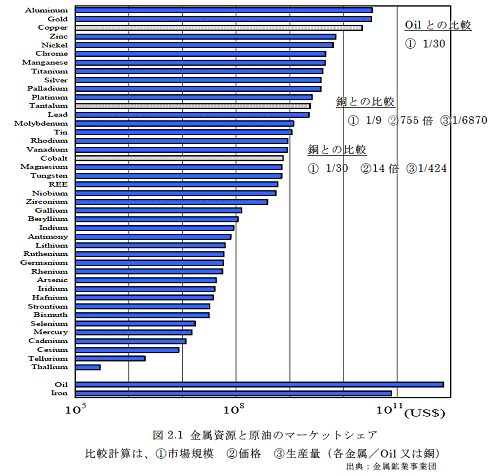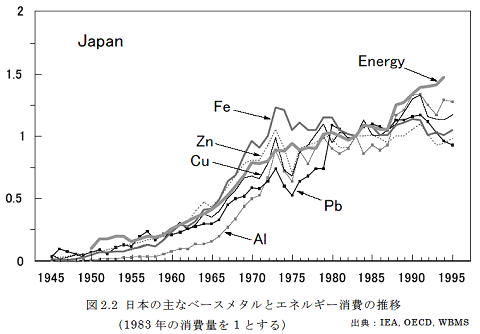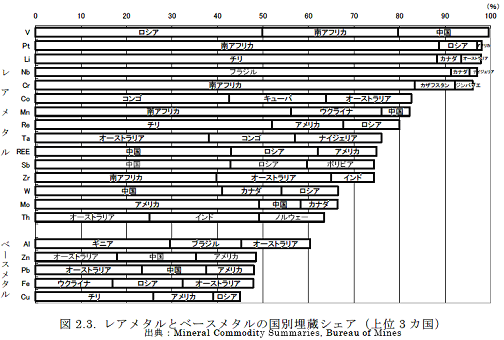   乲RIETI乲乮撈乯宱嵪嶻嬈尋媶強乴偵傛傞峼暔帒尮惌嶔僾儔僢僩僼僅乕儉偺拞偺亀庡梫峼暔帒尮偺嫙媼忈奞偑擔杮宱嵪偵媦傏偡塭嬁偵娭偡傞挷嵏尋媶亁偐傜乴 |
|
|
嵟廔峏怴擔丗2016擭12寧27擔
|
|
|||
| 慡斒 | 嬥懏峼暔帒尮 | 旕嬥懏峼暔帒尮 | 偦偺懠 |
|
儕儞僋乥 峼暔帒尮乥 峼暔帒尮榑乥峼暔帒尮恾乥 峼暔帒尮宱嵪榑乥峼暔帒尮壙奿乥 |
嬥懏峼暔帒尮乥 僋儕僥傿僇儖儅僥儕傾儖乥 |
岺嬈峼暔帒尮乥 搚愇帒尮乥 |
僴僶乕僩丒僺乕僋乥 峼嬈朄偵傛傞亀峼暔亁乥 |
|
丂抧媴帒尮乮Earth Resource乯偺3戝僌儖乕僾偺堦偮偑峼暔帒尮乮Mineral Resource乯偱偁傞丅峼暔帒尮偼嬥懏峼暔帒尮乮Metallic Mineral Resource乯偲旕嬥懏峼暔帒尮乮Non-metallic Mineral Resource乯偲偵暘偗傜傟傞丅 丂栚揑偺尦慺乮Element乯偵傑偱暘棧偟偰乮Separate乯棙梡偡傞応崌偑嬥懏峼暔帒尮偱偁傝丄揝乮Iron乯丒傾儖儈僯僂儉乮Aluminium丄Aluminum乯丒摵乮Copper乯丒垷墧乮Zinc乯丒墧乮Lead乯偺傛偆偵斾妑揑徚旓検偺懡偄儀乕僗儊僞儖乮Base Metal乯偲丄斾妑揑徚旓検偺彮側偄儗傾儊僞儖乮Rare Metal乯偲偵暘偗傜傟傞丅偝傜偵丄婱嬥懏乮Precious Metal丄Noble Metal乯偺傛偆側僌儖乕僾暘偗傕傛偔巊傢傟傞丅 丂堦曽丄嬥懏峼暔帒尮埲奜傪旕嬥懏峼暔帒尮偲屇傇偑丄偙傟傜偼岺嬈峼暔帒尮乮Industrial Mineral Resource乯偲傕屇偽傟傞丅傑偨丄嵒乮Sand乯傗嵒棙乮Gravel乯側偳偼搚愇帒尮乮Stone Resource乯偲屇偽傟傞偑丄偙偙偱偼旕嬥懏峼暔帒尮偵娷傔傞丅 |
| 儕儞僋 |
|
乻JOGMEC乼
|
亂僋儕僥傿僇儖儅僥儕傾儖亃乮Critical Material乯
乻儓乕儘僢僷乼
乻崑廈乼
乻塸崙乼
乻暷崙乼
| 峼暔帒尮乮Mineral Resource乯 |
|
|
|
|
Stephen A. Nelson巵偵傛傞亀Mineral
Resources亁 乮HP2012擭乯 |
丂Almost all Earth materials are used by humans for something. We require metals for making machines, sands and gravels for making roads and buildings, sand for making computer chips, limestone and gypsum for making concrete, clays for making ceramics, gold, silver, copper and aluminum for making electric circuits, and diamonds and corundum (sapphire, ruby, emerald) for abrasives and jewelry.乮埲壓棯乯 |
|
ILUKA偵傛傞亀Ore
Reserves & Mineral Resources亁 乮HP2012擭乯 |
A mineral resource is a concentration or occurrence of material of intrinsic economic interest on the earth乫s crust in such form and quantity that there are reasonable prospects for eventual economic extraction. The location, quantity, grade, geological characteristics and continuity of a mineral resource are known, estimated or interpreted from specific geological evidence and knowledge. Mineral resources are sub-divided, in order of increasing geological confidence, into Inferred, Indicated and Measured categories.乮埲壓棯乯 |
|
INSPIRE乮Infrastructure for Spatial Information
in Europe乯偵傛傞亀D2.8.III.21
Data Specification on Mineral Resources . Draft Guidelines亁 乮2011擭乯 |
乮慜棯乯In the INSPIRE Directive, Mineral Resources theme is defined as 乬Mineral resources including metal ores, industrial minerals, etc., where relevant including depth/height information on the extent of the resource乭.乮屻棯乯 |
|
ANGLO PLATINUM偵傛傞亀Mineral
Reserve & Resource Definitions亁 乮2003擭乯 |
Mineral Resource: a concentration or occurrence of material of economic interest in or on the earth's crust in such form and quantity that there are reasonable and realistic prospects for eventual economic extraction. The location, quantity, grade, continuity, and other geological characteristics of a Mineral Resource are known, estimated from specific geological evidence and knowledge, or interpreted from a well-constrained and portrayed geological model. Mineral Resources are subdivided, in order of increasing confidence in respect of geoscientific evidence, into Inferred, Indicated, and Measured categories. |
|
48th Annual Rocky Mountain Mineral Law Institute偵傛傞亀International Mineral Resource and Mineral Reserve Classification and Reporting Systems亁 乮2002擭乯 |
乮慜棯乯A Mineral Resource (reported as 乪in-situ mineralization estimates乫 in South Africa and as 乪potentially mineable mineralization乫 in the SME Reporting Guide) is a concentration or occurrence of material of intrinsic economic interest in or on the Earth乫s crust in such form and quantity that there are reasonable prospects for eventual economic extraction. Those portions of a mineralized deposit which do not have reasonable prospects for eventual economic extraction must not be included in a Mineral Resource. The geological characteristics of a Mineral Resource (such as location, quantity, grade, and丂continuity) are known, estimated, or interpreted from specific geological evidence and丂knowledge.乮屻棯乯 |
|
|
|
|
SOUTH AFRICAN MINERAL RESOURCE COMMITTEE (SAMREC)偵傛傞亀SOUTH AFRICAN CODE FOR REPORTING OF MINERAL RESOURCES AND MINERAL RESERVES (THE SAMREC CODE)亁 乮2000擭乯 |
The Code is applicable to all minerals, as defined in the Minerals Act No 50 of 1991, for which Public Reporting of Exploration Results, Mineral Resources and Mineral Reserves is required by the JSE. Minerals are defined in this Act as: any substance whether in solid, liquid or gaseous form, occurring naturally in or on the earth, in or under water or in tailings or dumps, and having been formed by or subjected to a geological process, excluding water but including sand, stone, rock, gravel and clay, as well as soil other than topsoil. |
|
USGS偺National Wetlands Research Center偵傛傞亀MINERAL RESERVES,
RESOURCES, RESOURCE POTENTIAL, AND CERTAINTY亁 乮丠擭乯 |
丂DEFINITIONS OF MINERAL RESERVES, resources,
resource potential, and certainty of assessment have been adopted
by the Geological Survey and U.S. Bureau of Mines to foster more
uniform terminology and more accurate communication. The exact
nomenclature used depends on the commodity being described, but
the unified terminology can be applied to all commodities. 丂The terminology of McKelvey (1972) for both discovered and undiscovered mineral resources, modified by Brobst and Pratt (1973, p. 1-8), has been adopted with minor changes for joint use by the U.S. Bureau of Mines and U.S. Geological Survey (1976a, b, 1980). This terminology applies to the description of the mineral endowment of an area. Resource assessment studies evaluate the likelihood of the occurrence of mineral deposits (resources) in terms of levels of mineral resource potential and the certainty of the assessment (Goudarzi, 1984). The likelihood of occurrence is not a measure of the resources themselves; consequently, the McKelvey classification should not be used in assessment studies except for descriptions of identified resources. RESERVES AND RESOURCES 丂The total mineral endowment of an area is divided into two major parts: identified resources and undiscovered resources. These, in turn, are subdivided on the basis of the adequacy of knowledge about the deposits and current economic factors (fig. 21). The definitions of reserve and resource terms as follows are quoted or paraphrased from Geological Survey Circular 831 (U.S. Bureau of Mines and U.S. Geological Survey, 1980). Resource.丂A concentration of naturally occurring solid, liquid, or gaseous materials in or on the Earth's crust in such form that economic extraction of a commodity is regarded as feasible, either currently or at some future time.乮埲壓棯乯 |
|
|
|
| 丂 | 佀峼嬈朄偵傛傞亀峼暔亁 |
|
Mining IQ乮a division of IQPC乯偵傛傞亀Mineral
Resource亁 乮HP2012擭乯 |
丂Mineral Resource is defined as a concentration or occurrence of natural, solid, inorganic or fossilized organic material in or on the Earth乫s crust in such form and quantity and of such a grade or quality that it has reasonable prospects for economic extraction. The location, quantity, grade, geological characteristics and continuity of a Mineral Resource are known, estimated or interpreted from specific geological evidence and knowledge. |
|
LKConsult偵傛傞亀Mineral
Resource亁 乮HP2012擭乯 |
What is a Mineral resource and how to quantify
it? 丂A mineral resource is by definition: 丂A concentration or occurrence of natural, solid, inorganic or fossilized organic material in or on the Earth乫s crust in such form and quantity and of such a grade or quality that it has reasonable prospects for economic extraction. The location, quantity, grade, geological characteristics and continuity of a mineral resource are known, estimated or interpreted from specific geological evidence and knowledge.乮埲壓棯乯 |
|
Office of the Queensland Parliamentary Counsel偵傛傞亀Queensland丂Mineral Resources Act 1989亁 乮2012擭乯 |
乮慜棯乯 6 Meaning of mineral 丂(1) A mineral is a substance亅 丂丂(a) normally occurring naturally as part of the earth乫s crust; or 丂丂(b) dissolved or suspended in water on or within the earth乫s 丂丂丂丂crust; or 丂丂(c) that may be extracted from a substance mentioned in paragraph (a) or (b). 丂(2) Subject to subsection (3), each of the following is a mineral亅 丂丂(a) any type of clay; 丂丂(b) foundry sand; 丂丂(c) coal seam gas; 丂丂丂丂Notes亅 丂丂丂丂丂1 For what is coal seam gas and incidental coal seam gas, see section 318AC. 丂丂丂丂丂2 See also part 7AA, division 8, subdivision 1. 丂丂(d) limestone; 丂丂(e) marble; 丂丂(f) a product that may be extracted or produced by an underground gasification process for coal or oil shale (mineral (f)) and another 丂丂丂丂丂product that may result from the carrying out of the process (also mineral (f)); 丂丂丂丂丂Examples of underground gasification processes亅combustion, consumption, heating, leaching and reaction 丂丂丂丂丂Example of another product亅gas desorbed as a result of an underground gasification process 丂丂(g) peat; 丂丂(h) salt, including brine; 丂丂(i) oil shale; 丂丂丂丂丂Note亅For what is oil shale, see section 318AD. 丂丂(j) silica, including silica sand; 丂丂(k) rock mined in block or slab form for building or monumental purposes. 丂(3) Despite subsections (1) and (2)亅 丂丂(a) clay (other than kaolin and bentonite) is only a mineral if it is mined for use for its ceramic properties; and 丂丂丂丂丂Examples of uses of clay for its ceramic properties亅 .丂丂丂丂丂丒 for brick or tile making .丂丂丂丂丂丒 for pottery making 丂丂(b) limestone, silica and silica sand is only a mineral if it is mined for use for its chemical properties; and 丂丂(c) mineral (f) is only a mineral if亅 丂丂丂(i) the coal or oil shale, from which it is extracted or produced, is held under a mineral development licence and it has been added to 丂丂丂丂丂丂the licence under section 208; or 丂丂丂(ii) the coal or oil shale, from which it is extracted or produced, is held under a mining lease and it is specified in the lease. 丂丂(d) each of the following is not a mineral亅 丂丂丂(i) soil, sand, gravel or rock (other than rock mentioned in subsection (2)(k)) if it is to be used, or to be supplied for use, as sand, 丂丂丂丂丂丂丂丂ravel or rock, whether intact or in broken form; 丂丂丂(ii) living matter; 丂丂丂(iii) steam or water. 乮屻棯乯 |
|
CIM Standing Committee on Reserve Definitions偵傛傞亀CIM
DEFINITION STANDARDS - For Mineral Resources and
Mineral Reserves亁 乮2010擭乯 |
乮慜棯乯A Mineral Resource is a concentration or occurrence of diamonds, natural solid inorganic material, or natural solid fossilized organic material including base and precious metals, coal, and industrial minerals in or on the Earth.s crust in such form and quantity and of such a grade or quality that it has reasonable prospects for economic extraction. The location, quantity, grade, geological characteristics and continuity of a Mineral Resource are known, estimated or interpreted from specific geological evidence and knowledge.乮屻棯乯 |
|
CIM Standing Committee on Reserve Definitions偵傛傞亀CIM DEFINITION STANDARDS On Mineral Resources and Mineral Reserves亁 乮2004擭乯 |
乮慜棯乯A Mineral Resource is a concentration or occurrence of natural, solid, inorganic or fossilized organic material in or on the Earth乫s crust in such form and quantity and of such a grade or quality that it has reasonable prospects for economic extraction. The location, quantity, grade, geological characteristics and continuity of a Mineral Resource are known, estimated or interpreted from specific geological evidence and knowledge.乮屻棯乯 |
   乲RIETI乲乮撈乯宱嵪嶻嬈尋媶強乴偵傛傞峼暔帒尮惌嶔僾儔僢僩僼僅乕儉偺拞偺亀庡梫峼暔帒尮偺嫙媼忈奞偑擔杮宱嵪偵媦傏偡塭嬁偵娭偡傞挷嵏尋媶亁偐傜乴 |
| 峼暔帒尮榑 |
| 峼暔帒尮恾 |
抧幙挷嵏憤崌僙儞僞乕乮HP/2014/12乯偵傛傞亀峼暔帒尮恾亁偐傜 |
| 峼暔帒尮宱嵪榑 |
| 峼暔帒尮壙奿 |
/Image2130.gif) 揝峼愇壙奿偺悇堏(擭師) 揝偺僺乕僋偼2011擭乮168乯 |
/Image2131.gif) 婱嬥懏壙奿偺悇堏(擭師) 嬥偺僺乕僋偼2012擭乮1,668乯丄僾儔僠僫偺僺乕僋偼2011擭乮1,720乯丒2008擭乮1,576乯 |
/Image2129.gif) 旕揝嬥懏壙奿偺悇堏(擭師) 傾儖儈僯僂儉偺僺乕僋偼2007擭乮2,640乯丒1988擭乮2,547乯丒2011擭乮2,401乯丄摵偺僺乕僋偼2011擭乮8,824乯丒2007擭乮7,132乯丄墧偺僺乕僋偼2007擭乮2,579乯丒2011擭乮2,401乯丄僯僢働儖偺僺乕僋偼2007擭乮37,136乯丒2011擭乮22,909乯丄庎偺僺乕僋偼2011擭乮26,051乯丒2013擭乮22,282乯丒2008擭乮18,467乯丄垷墧偺僺乕僋偼2006擭乮3,267乯 |
/Image2132.gif) 僂儔儞壙奿偺悇堏(擭師) 僂儔儞偺僺乕僋偼2007擭乮99乯丒2011擭乮56乯 |
| 乮姅乯FREELABO乮HP/2015/5乯偵傛傞悽奅宱嵪偺僱僞挔偺拞偺亀僐儌僨傿僥傿亁偐傜丂 | |
/Image2142.gif) 乮1乯 - 嘊 儀乕僗儊僞儖偺壙奿摦岦 拞崙摍怴嫽崙偱偺廀梫憹傪攚宨偵壙奿忋徃摍戝偒偔曄摦丅嬥梈彜昳壔傕曄摦偵塭嬁丅 /Image2143.gif) 乮2乯 - 嘊 儗傾儊僞儖偺壙奿摦岦乮僯僢働儖丄儌儕僽僨儞丄僞儞僌僗僥儞丄僾儔僠僫偺帠椺乯 儀乕僗儊僞儖偵斾傋偰丄儅乕働僢僩偑彫偝偄偨傔丄壙奿偺儃儔僥傿儕僥傿偑戝偒偄丅 帒尮僄僱儖僊乕挕帒尮丒擱椏晹乮2014/5乯偵傛傞亀峼暔帒尮傪傔偖傞尰忬偲壽戣亁偐傜 |
/Image2281.gif) Abundance-Price Source of data: USGS, EIA, CRC Handbook of Chemistry and Physics, others Price乮2011丠乯偵傛傞亀Energy Critical Elements - Securing Materials for Emerging Technologies亁偐傜 |
/Image2136.gif) 戞1-2-1-1恾丂崙嵺彜昳巗嫷偺悇堏 |
/Image2137.gif) 戞1-2-1-2恾丂庡梫帒尮丒怘椏壙奿偺悇堏乮夁嫀10擭丄寧師乯 |
| 宱嵪嶻嬈徣偵傛傞亀捠彜敀彂2011亁偺亀戞1復悽奅宱嵪偺尰忬偲壽戣丂戞2愡悽奅宱嵪偺書偊傞儕僗僋丂1丏帒尮H椏壙奿偺崅摣偺梫場偲偦偺塭嬁亁偐傜 | |
/Image2133.gif) 乮恾昞2乯嬥丒摵丒尨桘丒戝摛偺巗嫷偺悇堏 |
|
/Image2134.gif) 乮恾昞7乯奺旕揝儀乕僗儊僞儖偺巗嫷偲LME巜掕憅屔嵼屔偺悇堏 |
/Image2135.gif) 乮恾昞8乯奺婱嬥懏壙奿偲僪儖幚岠憡応偺悇堏 |
| 奌揷乮2011/3乯偵傛傞亀崙嵺彜昳巗嫷偺尰忬偲尒捠偟乣尨桘丄儀乕僗儊僞儖丄婱嬥懏丄擾嶻暔乣亁偐傜 | |
/Image2144.gif) 恾 6 摵媦傃傾儖儈僯僂儉偺崙嵺壙奿偺悇堏 |
/Image2145.gif) 恾 7 墧媦傃垷墧偺崙嵺壙奿偺悇堏 |
/Image2146.gif) 恾 8 嬥媦傃敀嬥偺崙嵺壙奿偺悇堏 |
/Image2147.gif) 恾 9 僯僢働儖偺崙嵺壙奿偺悇堏 |
| 奜柋徣宱嵪埨慡曐忈壽乮2008/7乯偵傛傞亀旕揝嬥懏偺廀媼摦岦偲偦偺攚宨亁偐傜 | |
| 嬥懏峼暔帒尮 |
/Image1807.gif) 峼暔帒尮偺慡懱憸丂 変偑崙偱偼丄揝丄儀乕僗儊僞儖乮摵丄墧丄垷墧摍乯丄婱嬥懏丄儗傾傾乕僗傪偼偠傔偲偡傞儗傾儊僞儖乮僯僢働儖丄儅儞僈儞摍乯側偳丄條乆側峼暔帒尮偑嶻嬈偱巊梡偝傟偰偄傞丅 |
/Image1808.gif) 峼庬暿惗嶻検偺斾妑乮2012擭乯 |
/Image1809.gif) 峼暔帒尮偺巗応婯柾偺斾妑乮2012擭乯 |
/Image1810.gif) 崙嵺嫞憟椡偺崅偄惢昳偵峼暔帒尮偼晄壜寚 |
| 帒尮僄僱儖僊乕挕帒尮丒擱椏晹乮2014/5乯偵傛傞亀峼暔帒尮傪傔偖傞尰忬偲壽戣亁偐傜 | |
/Image2684.gif) 尦慺偺悽奅惗嶻検偲壙奿乮2004擭乯 |
|
/Image2685.gif) 尦慺偺抧妅懚嵼搙偲壙奿乮2004擭乯 |
/Image2686.gif) 尦慺偺抧妅懚嵼搙偲R/P乮2004擭乯 |
| 嶳晊乮2008/5乯偵傛傞亀帒尮奐敪媄弍亁偐傜 | |
| 僋儕僥傿僇儖儅僥儕傾儖乮Critical Material乯 |
/Image2280.gif) 恾1. 暷崙偺僋儕乕儞僄僱儖僊乕宱嵪偵偍偗傞僋儕僥傿僇儖丒儅僥儕傾儖乮2011擭-2015擭乯 (弌揟丗U.S. DEPARTMENT OF ENERGY: 乬Critical Materials Strategy乭 (Dec. 2011)) |
/Image2279.gif) (弌揟丗U.S. DEPARTMENT OF ENERGY: 乬Critical Materials Strategy乭 (Dec. 2011)) |
/Image2278.gif) 恾2丏EU偺僋儕僥傿僇儖丒儘乕儅僥儕傾儖 (弌揟丗REPORT ON CRITICAL RAW MATERIALS FOR THE EU) |
|
/Image2277.gif) 仸仜丗critical, 仮丗near critical丄奺儗億乕僩傛傝昅幰嶌惉 1暷崙偵偍偗傞僋儕乕儞宱嵪偵娭偡傞抁婜揑側昡壙寢壥 2僴僀僥僋嶻嬈偵娭偡傞昡壙 |
/Image2276.gif) 恾4丏崙撪偵偍偗傞奺峼庬偺巗応婯柾乮昐枩$乯 |
/Image2275.gif) 恾5丏変偑崙偵偍偗傞埨掕嫙媼忋偺峼庬暿廳梫搙儅僢僾 |
/Image2272.gif) 恾6丏廳梫峼庬僀儊乕僕恾 |
| 桳夑乮2015/5乯偵傛傞亀嬥懏峼暔帒尮偺埨掕嫙媼偵娭偡傞堦峫嶡亁偐傜 | |
/Image2286.gif) Fig. 2. Discrimination diagram, commonly referred to as a criticality matrix, showing the relative economic importance of mineral commodities most susceptible to supply disruptions in today's resource market according to a recent report by the European Commission(2010). In this instance, only the economically important commodities with a high supply risk (N5 and 1, respectively) were classified as critical (purple field). Low supply-risk industrially important materials (beige field) can potentially become critical if any of the risk-defining variables (e.g., political stability in the source region) change. Commodities in the blue field (only a portion of it shown in this figure) are not considered critical in the cited report, but some of these commodities (in particular, Li) have been identified as near-critical or strategic by other organizations (cf. Table 1). The chemical symbols are followed by the criticality score, assigned to these different types of resources by Skirrow et al. (2013) based on their synthesis of several assessment reports, and by the weighted score of the relative importance of end-use applications for some of the metals for the US economy (separated by a forward slash), evaluated on a scale of 0 to 4 (Committee on Critical Mineral Impacts on the US Economy, 2008). Chakhmouradian et al.乮2015乯偵傛傞亀From 乬strategic乭 tungsten to 乬green乭 neodymium: A century of critical metals at a glance亁偐傜 |
|||||||||||||||||||||||||||
/Image2283.gif) * Supply data from the 54 materials assessed in this report, sources in Annex C |
/Image2282.gif) Figure 5: Updated criticality assessments for the EU for 2013 |
||||||||||||||||||||||||||||||||||||||||||||||||||||||||||||||||||||||||
|
/Image2284.gif) Figure 6: Comparison of EU critical raw materials from 2010 and 2013. *denotes new material in scope |
||||||||||||||||||||||||||||||||||||||||||||||||||||||||||||||||||||||||
|
/Image2285.gif) Figure 7: Changes in concentration and production-weighted World Governance Indicator (WGI) for selected metals grouped by 2008 tonnage. The values of the WGI vary modestly year to year therefore the large variations seen are due to changes in the relative (country) concentration of production. Source: Buijs, Sievers and Tercero Espinoza (2013): Proceedings of the ICE - Waste and Resource Management, 165 (4) 201-208. http://dx.doi.org/10.1680/warm.12.00010 |
||||||||||||||||||||||||||||||||||||||||||||||||||||||||||||||||||||||||
|
European Commission乮Ad hoc Working Group乯乮2014/5乯偵傛傞亀Report on Critical Raw Materials for the EU亁偐傜丂 亀Report on Critical Raw Materials for the EU Critical Raw Materials Profiles亁乮205p乯傕嶲徠丅丂丂 |
|||||||||||||||||||||||||||||||||||||||||||||||||||||||||||||||||||||||||
|
/Image2287.gif) Figure 1 Critical elements produced as by-products and co-products of base metals (Resnick Institute, 2011) |
||||||||||||||||||||||||||||||||||||||||
/Image2288.gif) Figure 2 Recycling rates for critical materials (UNEP, 2011a) |
/Image2289.gif) |
||||||||||||||||||||||||||||||||||||||||
| Department for Environment, Food and Rural Affairs乮2012/3乯乮塸崙乯偵傛傞亀A Review of National Resource Strategies and Research亁偐傜 | |||||||||||||||||||||||||||||||||||||||||
/Image2296.gif) Figure 1-1. Key Materials within the Periodic Table of the Elements |
|
/Image2297.gif) |
/Image2298.gif) |
/Image2290.gif) |
|
/Image2291.gif) Figure 5-1. Short-Term (0-5 years) Criticality Matrix |
/Image2294.gif) Figure 5-3. Comparison of Short-Term Criticality Assessment between this Strategy and the 2010 Critical Materials Strategy |
/Image2292.gif) Figure 5-2. Medium-Term (5-15 years) Criticality Matrix |
/Image2295.gif) Figure 5-4. Comparison of Medium-Term Criticality Assessment between this Strategy and the 2010 Critical Materials Strategy |
/Image2293.gif) |
|
| U.S.Department of Energy乮2011/12乯乮暷崙乯偵傛傞亀Critical Materials Strategy亁偐傜 | |
|
Energy Critical Elements - Securing Materials for Emerging
Technologies 1. Critical and strategic minerals will change with time. 2. Demand is high. 3. China will be a major force in the world of strategic and critical minerals. 4. The U.S.A. has the right geology to be a major force as well for many, but not all, minerals. Definition: Energy-critical elements (ECEs) are a class of chemical elements that currently appear critical to one or more new energy-related technologies. A shortage of these elements would significantly inhibit large-scale deployment, which could otherwise be capable of transforming the way we produce, transmit, store, or conserve energy. We reserve the term ECE for chemical elements that have not been widely extracted, traded, or utilized in the past, and are therefore not the focus of wellestablished and relatively stable markets. Constraints on availability of ECEs A. Crustal abundance, concentration, and distribution B. Geopolitical risk C. Risks of joint production D. Environmental and social concerns E. Response times in production and utilization |
/Image2299.gif) |
| Price乮2011丠乯偵傛傞亀Energy Critical Elements亅Securing Materials for Emerging Technologies亁偐傜 | |
| 岺嬈峼暔帒尮 |
| 搚愇帒尮 |
| 僴僶乕僩丒僺乕僋 |
/Image71.gif) Fig. 1. The exergy replacement cost loss of the main non-fuel mineral commodities on earth in the 20th century. /Image72.gif) Fig. 2. The exergy replacement cost loss of the main 15 non-fuel mineral commodities on earth in the 20th century, excluding iron and aluminium. /Image73.gif) Fig. 3. Depletion degree in % of the main non-fuel mineral commodity reserves. /Image74.gif) Fig. 4. The Hubbert peak applied to world iron, aluminium and copper production. Data in ktoe. /Image76.gif) Fig. 7. The exergy countdown of the most extracted minerals in the 20th century. Valero & Valero(2010)偵傛傞亀Physical geonomics: Combining the exergy and Hubbert peak analysis for predicting mineral resources depletion亁偐傜 |
| 峼嬈朄偵傛傞亀峼暔亁 |
|
侾丏奣梫 宱嵪嶻嬈徣乮HP/2011/12乯偵傛傞亀峼嬈朄戞榋忦偺擇偺峼暔傪掕傔傞惌椷偵偮偄偰亁偺拞偺亀峼嬈朄戞榋忦偺擇偺峼暔傪掕傔傞惌椷偵偮偄偰亁乮2011/12/20乯偐傜 |
|
乮揔梡峼暔乯 亀峼嬈朄亁偐傜 杮僂僃僽僒僀僩偵偍偗傞埖偄丗 |